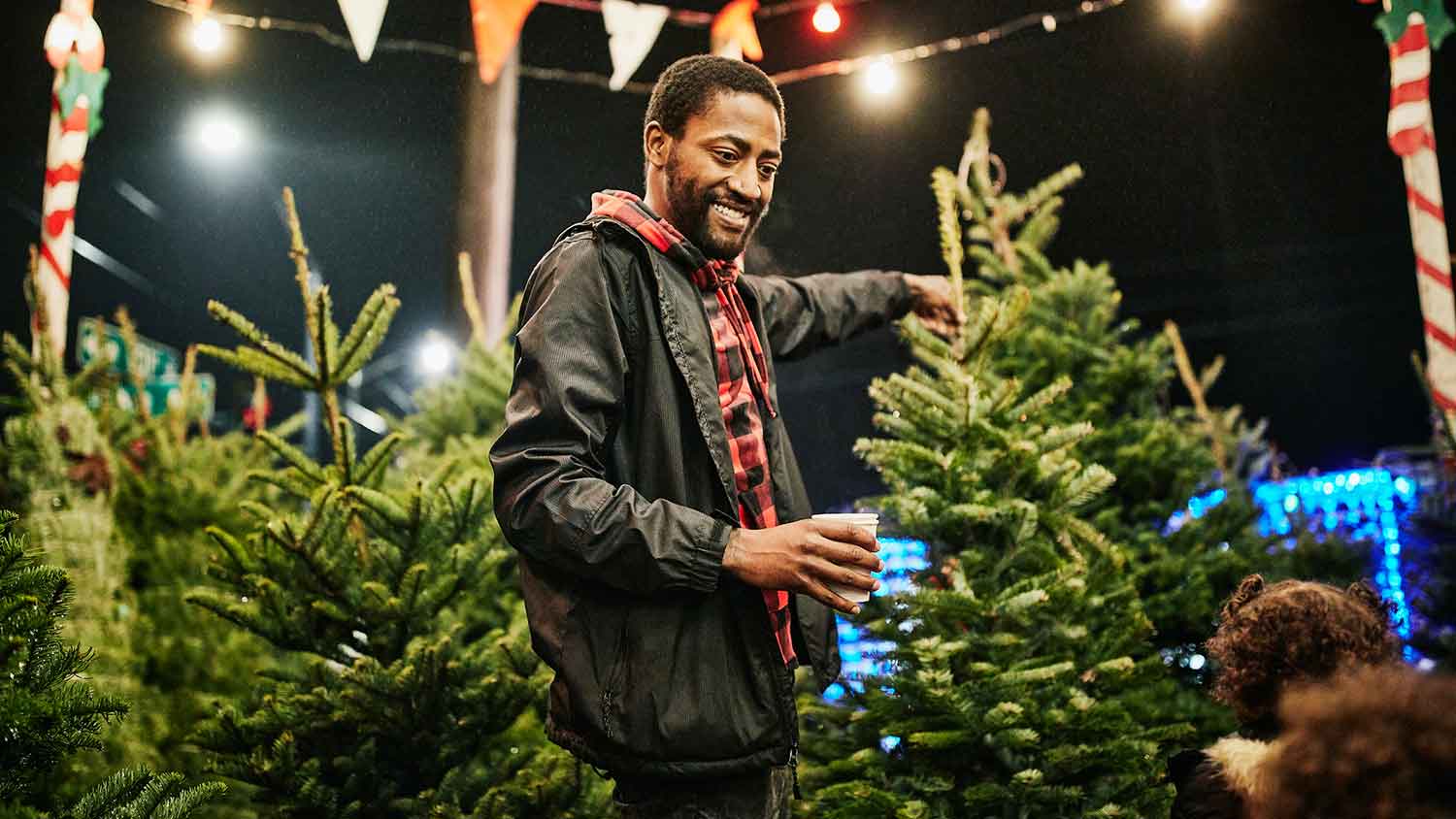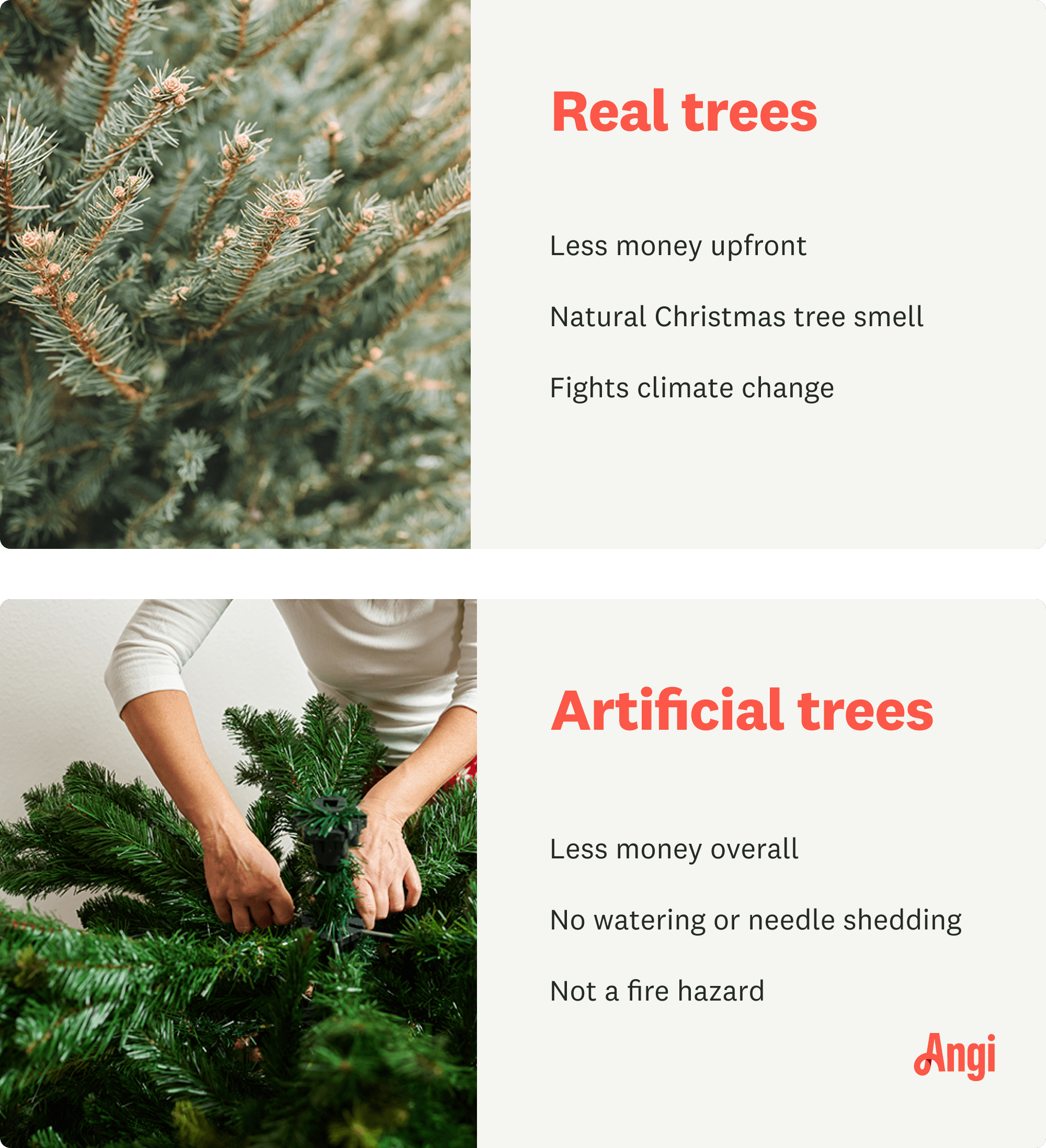
If you're dreaming of rocking around your—professionally decorated—tree this season, this is how much a Christmas tree decorating service will cost you.
A little TLC will give your tree a longer lifespan


The best time to buy a Christmas tree is Thanksgiving weekend.
A tree’s needles can tell you just how fresh it is.
A well-maintained tree can last up to six weeks.
Cutting the stump is key to making your tree last.
Christmas trees bring holiday magic indoors thanks to the fresh scent of pine needles, festive lights, and plenty of presents too. But how long do Christmas trees last, and is there a way to extend their lifespan?
The key to getting the most out of your live tree is knowing when to purchase it and how to take care of it, so it makes it all the way to the new year. Learn when to buy Christmas trees for the best results, and get care tips that’ll keep it looking beautiful for longer.
After buying real Christmas trees, the clock starts ticking immediately. From balsam fir to Scotch pine, how long do Christmas trees last? A healthy Christmas tree (that’s been properly watered up until the time you bought it) should last for five to six weeks before it begins to wilt and rapidly shed needles.
Depending on where you live, you can also go to a choose-and-cut Christmas tree farm so you can select the perfect Christmas tree that looks fresh and full.
The weekend after Thanksgiving is the best time to buy a Christmas tree. This ensures you’ll get to choose from the widest variety of trees, including the fullest and most beautiful—or a Charlie Brown-esque tree if that’s more your style.
It will also give you plenty of time to put lights on your Christmas tree and enjoy it throughout the holiday season. However, if you buy a tree before Black Friday weekend, you might be able to get a discount. Prices may get higher after Thanksgiving since more people will be shopping for trees.
If you’re looking for the lowest price, wait until the week of Christmas to buy your tree—you should be able to find heavy discounts—but you may not have the greatest or healthiest selection depending on what’s left.

Now that you know how long Christmas trees last, it’s time to make your selection. But unless you go to a choose-and-cut Christmas tree farm, you’ll be buying your tree off a lot.
Since that tree was cut and shipped to the retail location, you don’t know how much time it spent in the back of a truck or how long it’s been sitting on the lot.
Fortunately, there are a few ways to ensure you purchase a fresh tree:
Examine the needles: Bend one of the tree’s needles in half. A healthy fir tree’s needles should snap, while a fresh pine tree will bend but not break.
Observe the color: As evergreens dry out, they tend to take on a grayish tinge. Fresh trees will have a deep green color (or silvery blue if it’s a blue spruce).
Tap the tree: Gently lift the tree and tap the trunk on the ground. If it sheds more than just a few needles, look for a different tree.
Check the trunk: Feel the bottom of the tree’s trunk with your fingers. If it’s freshly cut, it should have a slightly sticky feel to it.
Purchase a hardier species: How long a Christmas tree lasts varies by species. Consider purchasing a fir or cypress tree, both of which will retain their needles longer than pine and spruce trees.
Caring for your tree properly is the key to keeping it fresh and festive for as long as possible. If you’re hiring a local holiday decorator to help, they’ll be able to give you tips to make your tree last longer and keep fresh garland from drying out.
Follow the steps below to extend your Christmas tree’s life:
Trim the trunk: Make your Christmas tree last longer by cutting 1 inch off the trunk to ensure sap from the original cut doesn’t block the water it needs to stay fresh. It only takes a few hours for a layer of sap to form over the tree trunk, so get it into water as quickly as possible.
Keep the tree away from heat: Position the tree so it’s not near any heat sources, such as radiators, fireplaces, or heating vents, to prevent the tree from drying out and reduce fire risk.
Water liberally: A Christmas tree can drink up to a gallon of water on the first day and a quart or more each day after. Water your Christmas tree with about 6 cups of water each day. Make sure the water line in the tree stand never dips below the bottom of the trunk to prevent sap from crusting over it.
Add a tree preservative: There are several Christmas tree preservatives on the market you can add to the water to help prolong its life. These products include a plant food, an additive that makes the water acidic, and thus easier for the tree to absorb, and a disinfectant that prevents mold growth.

If real Christmas trees don’t last long enough for you or you don’t want to deal with watering and cleaning up needles, an artificial tree might be the way to go. Let’s look at the pros and cons of real Christmas trees versus fake ones.
There are many factors to consider when deciding between a real or artificial Christmas tree. A real Christmas tree has that coveted pine tree scent that we all associate with Christmas.
Live trees are actually better for the environment than fake ones as well, according to The Nature Conservancy. Live Christmas trees are farmed, so cutting them down doesn’t negatively impact the environment, especially since farmers usually plant one to three saplings for each one they cut.
Over the eight to 10 years it takes for those trees to mature, they serve as habitat for birds and other wildlife and help fight climate change. And, when it’s time to dispose of your Christmas tree, many cities and towns will recycle live trees by turning them into mulch.
Artificial trees, on the other hand, are made of plastic and metal, which require a lot of resources to produce. While fake trees can last many years, they will eventually add plastic and metal to a landfill.
While fake trees may never offer the look and smell of a real tree, they’ve come a long way. The best fake trees can look nearly identical to a real tree. Though an artificial tree may cost a little more upfront, it will save you money in the long run since you’re not replacing it every year.
Fake trees also won’t dump needles on your living room floor, nor do they require constant watering. And, since they’re made of fire-resistant materials, they don’t present the fire hazard that live trees do.
Whether you choose a live tree or an artificial one, a local Christmas light installer can help you turn your home into a festive wonderland this season.
From average costs to expert advice, get all the answers you need to get your job done.

If you're dreaming of rocking around your—professionally decorated—tree this season, this is how much a Christmas tree decorating service will cost you.

How much does a Christmas decorating service cost? Turn your home into a winter wonderland this year—here are holiday decorating service prices.

Discover how homeowners are decorating with holiday lights this season, the top challenges they face, and tips for a hassle-free, festive display.

Discover the best steps to hang Christmas lights around your garage door to add even more cheer to your home's outdoor holiday display.

Is there a difference between cool white vs. warm white Christmas lights? Yes, but you can’t go wrong with either option. Learn what’s different here.

You can hang Christmas lights inside with a few simple steps and the right tools. Our guide will show you the best way to hang Christmas lights indoors.